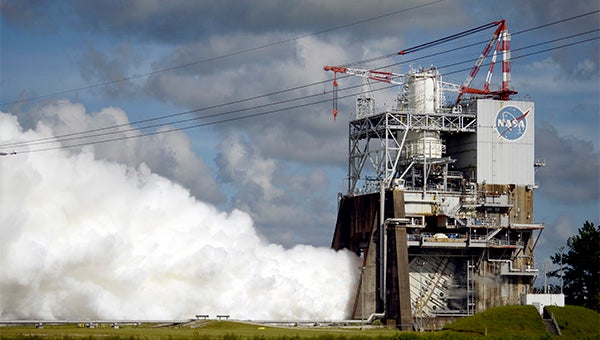NASA tests engine bound for Journey to Mars
Published 7:00 am Saturday, August 20, 2016

Take off: NASA engineers at Stennis Space Center tested a RS-25 engine that will be used to power the Space Launch System as a part of the Journey to Mars program. The SLS system will eventually hold four RS-25 engines, each with the power of a 12 million horsepower engine.
Photo by Julia Arenstam
On Thursday, NASA engineers tested an RS-25 engine that will be used to take astronauts to Mars.
The engine, assembled by Aerojet Rocketdyne, is one of 16 already assembled engines NASA will be using on the new Space Launch System.
A large crowd of media, spectators and politicians were present at the test launch on Thursday, held at Stennis Space Center.
U.S. Rep. Steven Palazzo, of Mississippi District 4, was present at the test.
“I’m hugely supportive of NASA’s Space Launch System, it’s what we’re doing to take us into deep space in a manned mission to Mars,” Palazzo said.
The new SLS will use four RS-25 engines, compared to its predecessor, the Space Shuttle, which used three.
The test on Thursday was just for one engine, Stennis plans to run another test with all four engines in 2017.
“Just imagine when we test all four of them at the same time. I think we’re going to shake windows in Mobile, Alabama,” Palazzo said.
Aerojet Rocketdyne was awarded a $1.2 billion contract to resume production of the RS-25 engine, which has not been built in 20 years, said Stephen Wofford, rocket engineer at Stennis.
“It’s also a smart federal investment that’s taking place right here in south Louisiana and in south Mississippi that’s going to one day lead to America launching American astronauts on American rockets from American soil,” Palazzo said.
The engine operated at 109 percent power for 420 seconds during the test at the A-1 test stand.
One RS-25 engine has the equivalent of a 12 million horsepower, RS-25 test project manager Ronnie Rigney said.
“It’s always emotional for me to watch one of these tests because as an engineer I appreciate all of these extremes that are going on inside that piece of machinery,” Rigney said. “I consider it almost a work of art as opposed to an engineering masterpiece.”
Renovations are currently underway on the B-1 and B-2 test stand where the core stages of the SLS system will be tested next year.
Stennis and other federal assets with the military are the single largest economic driver in south Mississippi, Palazzo said.
“Its economic impact is over 2 billion dollars and leaves about 30 to 40 thousand jobs that are directly related,” Palazzo said. “We want to see more of those jobs, not less of it.”
In April, Stennis celebrated its 50-year anniversary of the first Apollo test firing.
“We have a rich history of testing everything that’s sent an American astronaut into space,” Rigney said.





